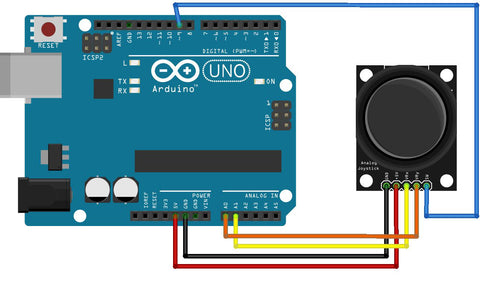PS2 Joystick Module


Variable Resistors (Potentiometers) Within the joystick's base, there are two variable resistors (potentiometers) - one for each axis. These resistors change their resistance values based on the position of the joystick in the X and Y directions.
Analog Output The varying resistance of the potentiometers generates analog voltage signals proportional to the joystick's position on each axis. For example, when the joystick is centered, the resistance and voltage output are at a midpoint. As the joystick is moved in any direction, the resistance and voltage output change accordingly.
InterfaceThe PS2 game joystick module often has pins or connectors that allow easy interfacing with microcontrollers or other electronic circuits. The outputs may be in the form of analog voltages, making them compatible with ADC (Analog-to-Digital Converter) inputs on microcontrollers.
Gaming In some DIY gaming projects, joystick modules are used to create custom gaming controllers for retro gaming systems or other interactive games.
Remote Control Systems Joystick modules can be utilized in remote control devices, such as RC (radio-controlled) vehicles or drones, for intuitive control of movement and direction.
Pan-and-Tilt Camera Control Joysticks are employed in camera systems to control pan and tilt movements, useful in photography, videography, and surveillance applications.
Industrial Control Systems Joystick modules can be integrated into various industrial control systems where precise analog control is required. Overall, the joystick module offers a versatile and intuitive way to interact with electronic projects and devices, making it a popular choice for hobbyists, makers, and engineers working on a wide range of applications.

PS2 Joystick Module
Available:In Stock
- Product SKU: KG005
₹ 35
₹ 59
Need Volume Discounts? Deals are specially designed for you. Click here
Need Customization? Provide us more details Click here
Warehouse Details

- Order within

Specification
Description
A PS2 game joystick module is an input device commonly used in electronic projects and DIY applications to provide analog control over various systems. It resembles the traditional joystick found on gaming consoles and is designed to translate physical movement into electrical signals that can be processed by microcontrollers, computers, or other electronic devices.The ps2 joystick module typically consists of the following components:
Joystick Mechanism The main component is the physical joystick mechanism, which allows users to move the stick in different directions. It usually has two axes of movement: the X-axis (left-right) and the Y-axis (up-down). Some joystick modules also come with additional buttons for extra functionality.Variable Resistors (Potentiometers) Within the joystick's base, there are two variable resistors (potentiometers) - one for each axis. These resistors change their resistance values based on the position of the joystick in the X and Y directions.
Analog Output The varying resistance of the potentiometers generates analog voltage signals proportional to the joystick's position on each axis. For example, when the joystick is centered, the resistance and voltage output are at a midpoint. As the joystick is moved in any direction, the resistance and voltage output change accordingly.
InterfaceThe PS2 game joystick module often has pins or connectors that allow easy interfacing with microcontrollers or other electronic circuits. The outputs may be in the form of analog voltages, making them compatible with ADC (Analog-to-Digital Converter) inputs on microcontrollers.
Applications of ps2 joystick module include:
Robotics Joystick modules are used in robot control systems to provide manual control over the robot's movements, allowing operators to navigate the robot in real-time.Gaming In some DIY gaming projects, joystick modules are used to create custom gaming controllers for retro gaming systems or other interactive games.
Remote Control Systems Joystick modules can be utilized in remote control devices, such as RC (radio-controlled) vehicles or drones, for intuitive control of movement and direction.
Pan-and-Tilt Camera Control Joysticks are employed in camera systems to control pan and tilt movements, useful in photography, videography, and surveillance applications.
Industrial Control Systems Joystick modules can be integrated into various industrial control systems where precise analog control is required. Overall, the joystick module offers a versatile and intuitive way to interact with electronic projects and devices, making it a popular choice for hobbyists, makers, and engineers working on a wide range of applications.
Pinout Diagram

Pin Configuration Of PS2 Joystick Module Breakout Sensor
- Grand: Ground terminal of Module
- +5v: Positive supply terminal of Module
- VRx: Voltage Proportional to X-axis
- VRy: Voltage Proportional to Y-axis
- SW: Switch
Technical Details
- Operating Voltage: 5V
- Internal Potentiometer value: 10k
- 2.54mm pin interface leads
- Operating temperature: 0 to 70 °C
Physical Attributes of ps2 game joystick module
- Dimensions (mm) L x W x H : 38 x 27 x 29
- Weight (gm): 13
Integration with Arduino of PS2 game joystick module

Sample Code
Integration with Raspberry Pi

Sample Code
Additional Details of ps2 game joystick module
- Two independent Potentiometer: one for each axis ( X and Y)
- Auto return to the center position
- Low weight
- Cup-type Knob
- Compatible to interface with Arduino or with most microcontrollers
Product Video
Documentation
- a- Datasheet
Package Includes
- 1 x PS2 Joystick Module Breakout Sensor



























